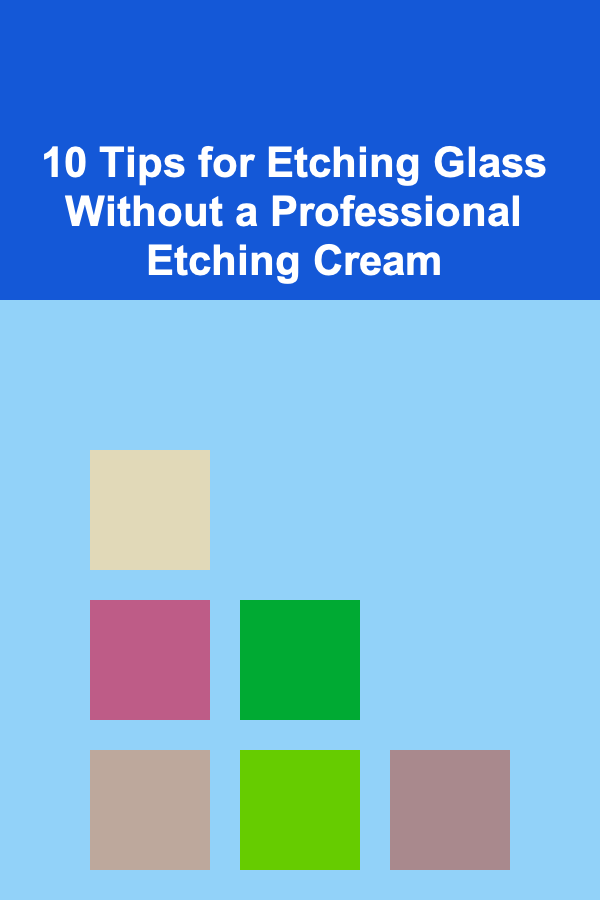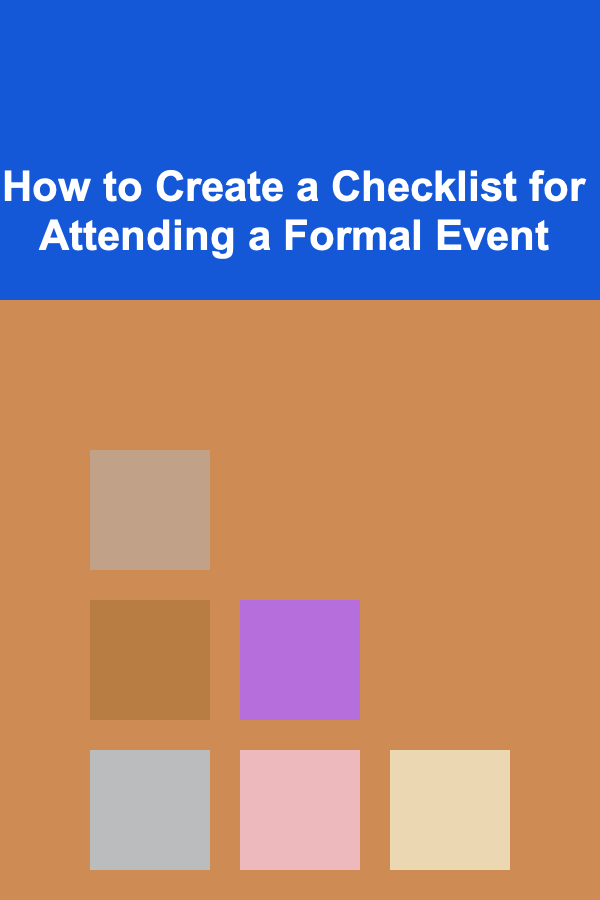
10 Tips for Etching Glass Without a Professional Etching Cream
ebook include PDF & Audio bundle (Micro Guide)
$12.99$10.99
Limited Time Offer! Order within the next:

Etching glass is a technique that can be used to create intricate designs on glass surfaces, making it a popular choice for DIY projects, personalized gifts, or home décor. While professional etching creams are readily available and often recommended, they can be expensive and sometimes require specific safety precautions. However, it's entirely possible to achieve beautiful glass etching effects without the need for professional creams. This article will guide you through ten practical and creative tips for etching glass using simple, affordable materials that you can find around your home.
Use a Homemade Etching Solution
If you want to etch glass without spending money on professional products, creating your own etching solution is a cost-effective and straightforward approach. One of the most common and accessible methods involves using a mixture of baking soda and vinegar. This solution can create a subtle etched effect on glass surfaces.
How to Create Your Etching Solution:
- Ingredients: Baking soda, vinegar, water.
- Instructions: Mix one tablespoon of baking soda with a small amount of vinegar to form a paste. Apply this paste to the glass surface using a sponge or brush. Let it sit for about 10-15 minutes and then rinse it off with water. While the result may not be as bold as professional etching creams, it creates a beautiful, frosted effect that is ideal for smaller, simple designs.
This technique works best on surfaces like glass jars or windows, where a light etching is sufficient.
Use Masking Tape or Stencils for Clean Designs
For precise, clean designs when etching glass, masking tape or stencils are essential tools. These materials act as a protective barrier that prevents the etching solution from reaching areas you want to remain clear. By creating or purchasing stencils, you can apply intricate designs to your glassware with ease.
How to Use Masking Tape or Stencils:
- Cut the masking tape into shapes or patterns and adhere it to the glass surface where you want to keep the design clear.
- Alternatively, use a pre-made stencil and tape it securely to the glass.
- Once the tape or stencil is in place, apply your etching solution over the exposed areas.
- After the etching is complete, remove the tape or stencil to reveal your design.
This method is ideal for creating logos, monograms, or custom artwork on glass items.
Sandblasting for Detailed Etching
Sandblasting is a technique that uses pressurized air to blast tiny particles of sand against a glass surface. This process creates a deep, professional-looking etching effect. Although sandblasting requires specialized equipment, you can rent or purchase affordable sandblasting kits that are suitable for DIY projects.
How to Use Sandblasting:
- Set up your sandblasting equipment in a well-ventilated area and wear protective gloves and goggles.
- Tape your design to the glass or use a stencil for intricate patterns.
- Gently blast the sand over the exposed areas of the glass, moving the nozzle evenly to create a consistent texture.
- Once finished, rinse the glass thoroughly to remove any excess sand.
Sandblasting produces a more permanent and robust etching effect compared to other methods and is perfect for more complex designs.
Use a Diamond Tip Engraving Tool
For those who want a more hands-on, precise method of etching glass, a diamond tip engraving tool is an excellent choice. These tools are designed for detailed etching and can be found in many craft stores. They allow you to carve designs directly into the glass, creating a permanent etched effect.
How to Use a Diamond Tip Engraving Tool:
- Hold the engraving tool like a pen and lightly trace over your design, applying even pressure.
- The diamond tip will scratch the glass, creating an etched appearance.
- Use a steady hand and make sure to take breaks if you're working on a large area to avoid fatigue and uneven pressure.
This method is great for smaller projects or personalizing glass objects with initials, names, or simple designs.
Try Lemon Juice for a Mild Etching Effect
Lemon juice is another natural ingredient that can help you etch glass. While it's not as potent as commercial etching creams, it can still produce a subtle frosted effect, especially on less durable glass.
How to Use Lemon Juice:
- Apply fresh lemon juice to a cotton ball or sponge and gently rub it over the surface you wish to etch.
- Leave the juice on for 5-10 minutes to allow it to work, then rinse the glass with water.
- This method is ideal for creating a light etching on glass surfaces, such as glasses, jars, or small decorative items.
Although the results are more delicate, lemon juice is a safe and non-toxic option for mild etching.
Create a Custom Frosted Effect with a Spray
If you're looking for an easy way to achieve a frosted glass effect, a frosted glass spray is a great alternative to professional etching creams. These sprays are designed to mimic the appearance of etched glass and can be used to create a uniform frosted finish.
How to Use Frosted Glass Spray:
- Clean the glass thoroughly to ensure no dirt or oil is present.
- Shake the spray can well and hold it about 12 inches away from the glass.
- Apply the spray in a light, even coat over the entire surface.
- Let it dry, and apply a second coat if necessary for a more opaque effect.
This method is great for larger projects like windows or glass doors, providing a professional-looking finish without the need for etching tools.
Use a Sharpie and Baking Soda to Create Temporary Etchings
For a fun, temporary etching effect, you can use a Sharpie marker and baking soda to create an etched appearance. This method is more about creating a frosted look that lasts for a short period rather than a permanent design.
How to Use Sharpie and Baking Soda:
- Draw your design onto the glass using a Sharpie marker.
- Sprinkle baking soda over the design and press lightly to help it stick.
- Spray the area with a bit of water, then wait for a few minutes.
- The combination of the marker and baking soda creates a temporary etched effect, which can be wiped away after use.
This method is particularly useful for temporary or seasonal projects, like creating etched glassware for special events.
Experiment with Glass Etching Creams for DIY Etching
If you prefer a more traditional method without resorting to professional etching creams, you can still make your own DIY etching cream using readily available chemicals. A common DIY recipe uses a combination of hydrogen peroxide, salt, and a little bit of vinegar.
How to Make Your Etching Cream:
- Mix equal parts of hydrogen peroxide and salt to create a paste.
- Add a small amount of vinegar to the mixture to thicken it.
- Apply the paste to your glass surface, ensuring it covers the exposed areas.
- Let it sit for around 20 minutes before washing it off with water.
This homemade etching cream works similarly to commercial products, allowing for detailed and long-lasting etchings.
Use an Acidic Solution for Deeper Etching
For more durable and permanent etching, you can use acidic solutions like muriatic acid or phosphoric acid, which are more effective than lemon juice or vinegar. These acids can etch the surface of the glass more aggressively, leaving behind a more defined, long-lasting design.
How to Use an Acidic Solution:
- Dilute the acid solution with water, following the manufacturer's safety instructions.
- Apply the acid to the glass using a brush or sponge, ensuring that the design is well protected.
- Let it sit for a few minutes before rinsing the surface thoroughly.
This method requires care and caution, as acidic solutions can be dangerous. Always wear gloves and goggles, and work in a well-ventilated area.
Combine Techniques for Unique Effects
To achieve truly unique and custom designs, feel free to combine the various etching techniques discussed. For example, you can use sandblasting for a deep etching and then enhance the design with a frosted spray or engraving tool for added texture and depth.
Creative Combinations:
- Combine stencils with sandblasting for detailed, multi-layered designs.
- Use homemade etching solutions for subtle effects and enhance them with diamond tip engraving for precision.
- Layer different etching techniques to create contrasting textures on the same piece.
By mixing and matching these techniques, you can create custom glass items that are truly one-of-a-kind.
Conclusion
Etching glass is a rewarding and creative way to personalize items and add intricate designs to glass surfaces. With the tips provided in this article, you don't need professional etching creams to achieve beautiful results. Whether you prefer a natural approach with lemon juice, a hands-on technique with engraving tools, or using affordable alternatives like frosted spray, there are plenty of DIY methods to explore. Remember to always work carefully and safely, and most importantly, have fun with your glass etching projects!
Reading More From Our Other Websites
- [Screen Printing Tip 101] Step-by-Step Tutorial: Screen Printing Vibrant Patterns on Cotton T-Shirts
- [Home Family Activity 101] How to Plan an Indoor Camping Trip for the Whole Family
- [Organization Tip 101] How to Mix Vintage and Modern with Industrial Lighting Fixtures
- [Needle Felting Tip 101] Creative Ideas to Expand Your Needle Felting Skills Beyond the Basics
- [Personal Care Tips 101] How to Revitalize Your Nails After Frequent Use of Nail Polish Remover
- [Beachcombing Tip 101] Sea Pottery 101: A Beginner's Guide to Collecting and Crafting Coastal Ceramics
- [Digital Decluttering Tip 101] Sentimental Items Made Simple: A Compassionate Guide to Letting Go
- [Weaving Tip 101] Choosing the Perfect Yarn: Color, Texture, and Weight for a Stunning Hand-Woven Scarf
- [Polymer Clay Modeling Tip 101] Best Polymer Clay Resin Casting Techniques: Combining Clay & Resin for Endless Possibilities
- [Personal Investment 101] Earn Money by Developing and Selling Pre-Trained Deep Learning Models

How to Balance Saving for the Future and Enjoying Life Today
Read More
How to Create a Checklist for Attending a Formal Event
Read More
How to Use Wall Shelves for Effective Storage
Read More
The IT Director's Toolkit: Proven Methods for Leading Digital Transformation
Read More
How To Create Graphics for Online Courses
Read More
10 Tips for Using Digital vs. Physical Author Planners
Read MoreOther Products

How to Balance Saving for the Future and Enjoying Life Today
Read More
How to Create a Checklist for Attending a Formal Event
Read More
How to Use Wall Shelves for Effective Storage
Read More
The IT Director's Toolkit: Proven Methods for Leading Digital Transformation
Read More
How To Create Graphics for Online Courses
Read More